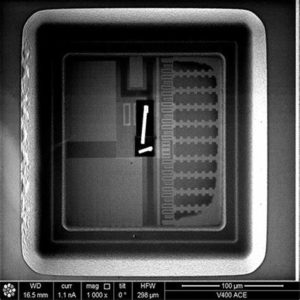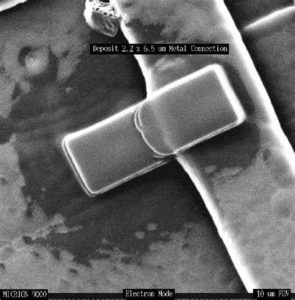Unlock Microcontroller ATMEGA8535L Code
Unlock Microcontroller ATMEGA8535L Code from its memory, the code will be extracted from MCU in the format of heximal after disable the security fuse bit and redeposite the circuitry pattern by focus ion beam technique;

Unlock Microcontroller ATMEGA8535L Code from its memory, the code will be extracted from MCU in the format of heximal after disable the security fuse bit and redeposite the circuitry pattern by focus ion beam technique
The ATmega8535 provides all the features of the AT90S8535. In addition, several new features are added. The ATmega8535 is backward compatible with AT90S8535 in most cases. However, some incompatibilities between the two microcontrollers exist.
To solve this problem, an ATMEGA8535L compatibility mode can be selected by programming the S8535C fuse. ATmega8535 is pin compatible with ATMEGA8535L, and can replace the ATMEGA8535L on current Printed Circuit Boards. However, the location of fuse bits and the electrical characteristics differs between the two devices.
Port A serves as the analog inputs to the A/D Converter. Port A also serves as an 8-bit bi-directional I/O port, if the A/D Converter is not used. Port pins can provide internal pull-up resistors (selected for each bit). The Port A output buffers have symmetrical drive characteristics with both high sink and source capability.
When pins PA0 to PA7 are used as inputs and are externally pulled low, they will source current if the internal pull-up resistors are activated. The Port A pins are tri-stated when a reset condition becomes active, even if the clock is not running. Port B is an 8-bit bi-directional I/O port with internal pull-up resistors (selected for each bit). The Port B output buffers have symmetrical drive characteristics with both high sink and source capability.
As inputs, Port B pins that are externally pulled low will source current if the pull-up resistors are activated. The Port B pins are tri-stated when a reset condition becomes active, even if the clock is not running. Port C is an 8-bit bi-directional I/O port with internal pull-up resistors (selected for each bit). The Port C output buffers have symmetrical drive characteristics with both high sink and source capability.
As inputs, Port C pins that are externally pulled low will source current if the pull-up resistors are activated. The Port C pins are tri-stated when a reset condition becomes active, even if the clock is not running. Port D is an 8-bit bi-directional I/O port with internal pull-up resistors (selected for each bit). The Port D output buffers have symmetrical drive characteristics with both high sink and source capability.
As inputs, Port D pins that are externally pulled low will source current if the pull-up resistors are activated. The Port D pins are tri-stated when a reset condition becomes active, even if the clock is not running.
Tags: microcontroller dump archive unlocking,microcontroller dump code unlocking,microcontroller dump content unlocking,microcontroller dump data unlocking,microcontroller dump eeprom unlocking,microcontroller dump file unlocking,microcontroller dump firmware unlocking,microcontroller dump information unlocking,microcontroller dump memory unlocking,microcontroller dump program unlocking


